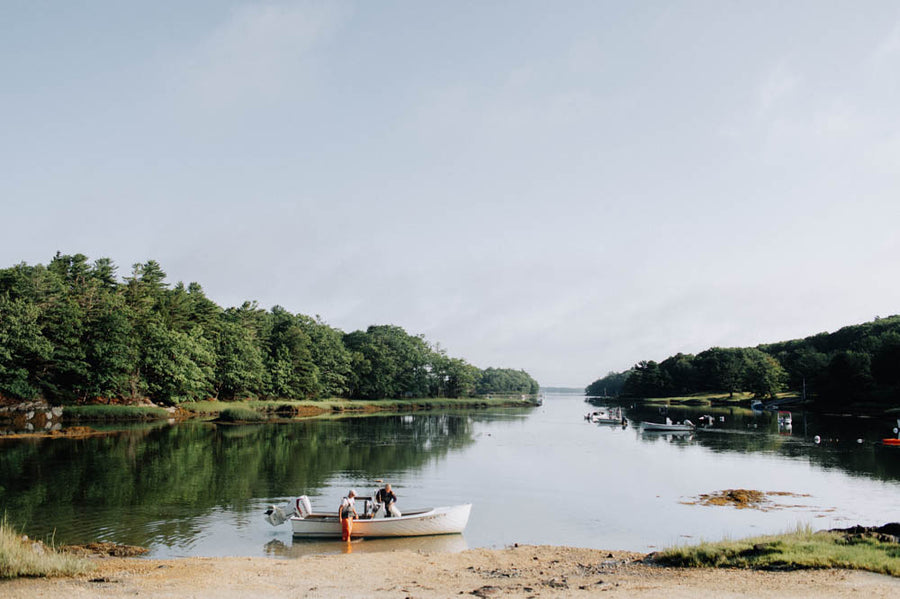What Makes The Damariscotta So Fabulous for Growing Oysters and More:
Tradition has called the Damariscotta a river, but ecologists call it an estuary – the tidal interface between river and ocean where freshwater and saltwater ecosystems mix. The beautiful scenery, clean waters and diverse ecosystem makes the Damariscotta an ideal environment for fisheries, water sports and wildlife sightings.

The Damariscotta is also home to Glidden Point Oysters and over 15 other oyster farms, producing around 80% of Maine’s oyster population. These farms work collectively to produce some of the best oysters in the world. There is a sense of camaraderie among the farmers who do the long winded, fastidious and back breaking work that is required to grow a world class oyster. We thought it would be fun to put together a bit of background and history on why the Damariscotta is such an idyllic place for growing some mouth watering oysters.
A Brief History of the River:

Native American Wabanaki people have inhabited the shores of the Damariscotta river for over 12,000 years. The Wabanaki People have left behind plenty of evidence to prove the river was bountiful with Oysters. There are shell middens, or discarded shell heaps, left along the banks of the river. Some of these middens, most notably the Whaleback and Glidden Shell Midden, have been dated back as far as 1000-2000 years old.The Whaleback Midden was estimated to be about 30 feet deep and more than 1,600 feet long. Even after tons of shells were mined for lime and chicken feed, vast mounds remain a short walk from Damariscotta’s downtown.

Ship Building was a major industry in the river for over 150 years. Between 1779 and 1924 as many as 29 shipyards built more than 400 ships, including 5-masted schooners, full-rigged ships, brigs, barks, and sloops. Ships built here sailed the entire globe with destinations near and far, exporting timber, salted fish, bricks and ice and returning with coal, spices, tropical fruits, and other trade items. Little remains of this era although occasionally at low tide you might spot a few pilings or stone and granite walls once associated with some of the larger boatyards.

Damariscotta is a Wabanaki word for “river of many fishes”. This name is typically attributed to the famous Alewife population of the river. Each May, thousands of alewives (a small herring-like fish) migrate upriver into the Great Salt Bay and then climb a 40-foot fish ladder to spawn in freshwater Damariscotta Lake. This is such a celebrated occurrence that each year there is an alewife festival hosted by the Damariscotta mills.
The estuary also provides habitat for a diverse population of seals, osprey, eagles, lobsters, horseshoe crabs, and numerous species of fish, including striped bass, bluefish, herring, flounder, and many more.
The Beginning of Today’s Oyster Industry

In the 1970s pioneer aquaculture entrepreneurs grew mussels and oysters in the river, helped by the University of Maine’s Ira C. Darling Center in Walpole, a research station on the river. The Darling Center’s Professor Herb Hidu encouraged anyone who would listen to grow oysters, and he influenced a generation of Maine aquaculturists.

Glidden Point was started in 1987 by Barb Scully. She was one of the OG farmers in the area and prided herself on taking the time and effort to grow some incredible oysters. Her efforts starting the business provided a great foundation for the future of Glidden Point. She was able to secure our three lease sights on the river. These lease sights are areas of river covering both river bottom and water surface, each spanning about 10 acres, totaling in about 30 acres of Oyster production. One lease is located just off downtown Damariscotta, a perfect place to start our seed or “baby oysters”. This is ideal for babies because the area has a high concentration of food and nutrients being brought in from the Great Salt Bay.
So.. What Makes the River so fabulous for growing Oysters?

The waters of the Damariscotta are some of the cleanest coastal waters in the State of Maine. Our local wildlife and our economy both rely on clean water to stay productive and healthy. The river has ideal oyster-growing conditions: the right level of salinity (ranging from 28 to 32 ppt) with a fresh water mix, and slightly warmer temperatures (avg 39-47 degrees) than the open sea.

The tidal range in the Damariscotta is significant – as much as eleven feet – and at low tide there are extensive areas of the upper estuary that can be inaccessible by boat. This large tidal range brings 30 billion gallons of water surging through the river on each tidal cycle. This is ideal because oysters are master filter feeders. One oyster can filter up to 50 gallons of water a day. Having billions of gallons of water pumping through the river provides the oysters with plenty of water to filter. Not only is this water important, but because Oysters eat phytoplankton and small bits of algae suspended in the water, this is ultimately what feeds our oysters and helps them grow to a healthy market size.

The Great Salt Bay are the headwaters located just north of the Damariscotta downtown bridge. This area is where the fresh water combines with the salt water. It is shallower and warmer, becoming a perfect environment for Phytoplankton and algae growth. These attributes give The Great Salt Bay the nickname the “engine” of the river, because it provides so much of the energy and nutrients to keep our shellfish population growing.

The combination of clean water, diverse species, water temperature, salinity, the great salt bay and proximity to both fresh and saltwater is truly what creates a perfect recipe for the unique and delicious Damariscotta Oyster. We are truly grateful to be a part of this river community and continue to advocate for the care and growth of the Oyster population.
My wife and I just watched an episode of Maine Cabin Masters featuring your oyster farm shack. I was stoked, having received 36 Glidden Point oysters from my friend Mike Kane, then ordering three dozen myself a couple weeks later.
They are divine!
You have a good life!!!!


Written by
Glidden Point Company
Your Questions Answered: Wild vs. Farmed Oysters At Glidden Point, we are nearly 100% farmed by design. Aquaculture...
Wild vs. Farmed Maine Oysters: What’s the Difference and Why It Matters


Written by
Glidden Point Company
It doesn't get any more New England-y than Maine. Winter comes early and stays late. But we make the best of it by finding ways to warm our bodies and our souls. This year we had r...


